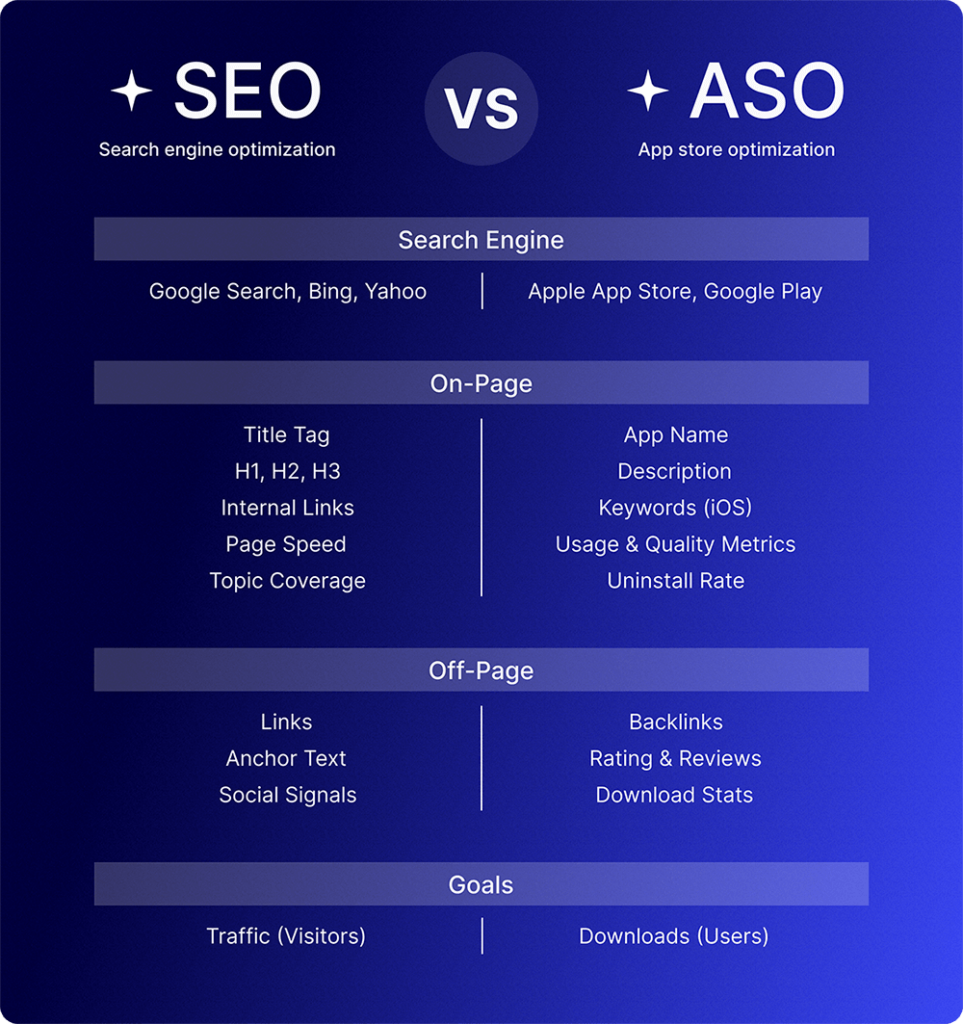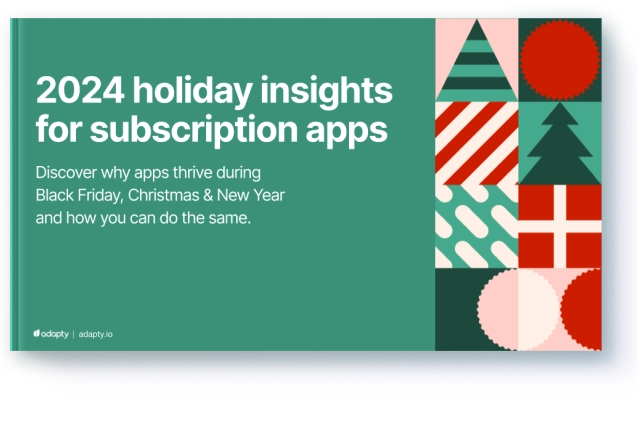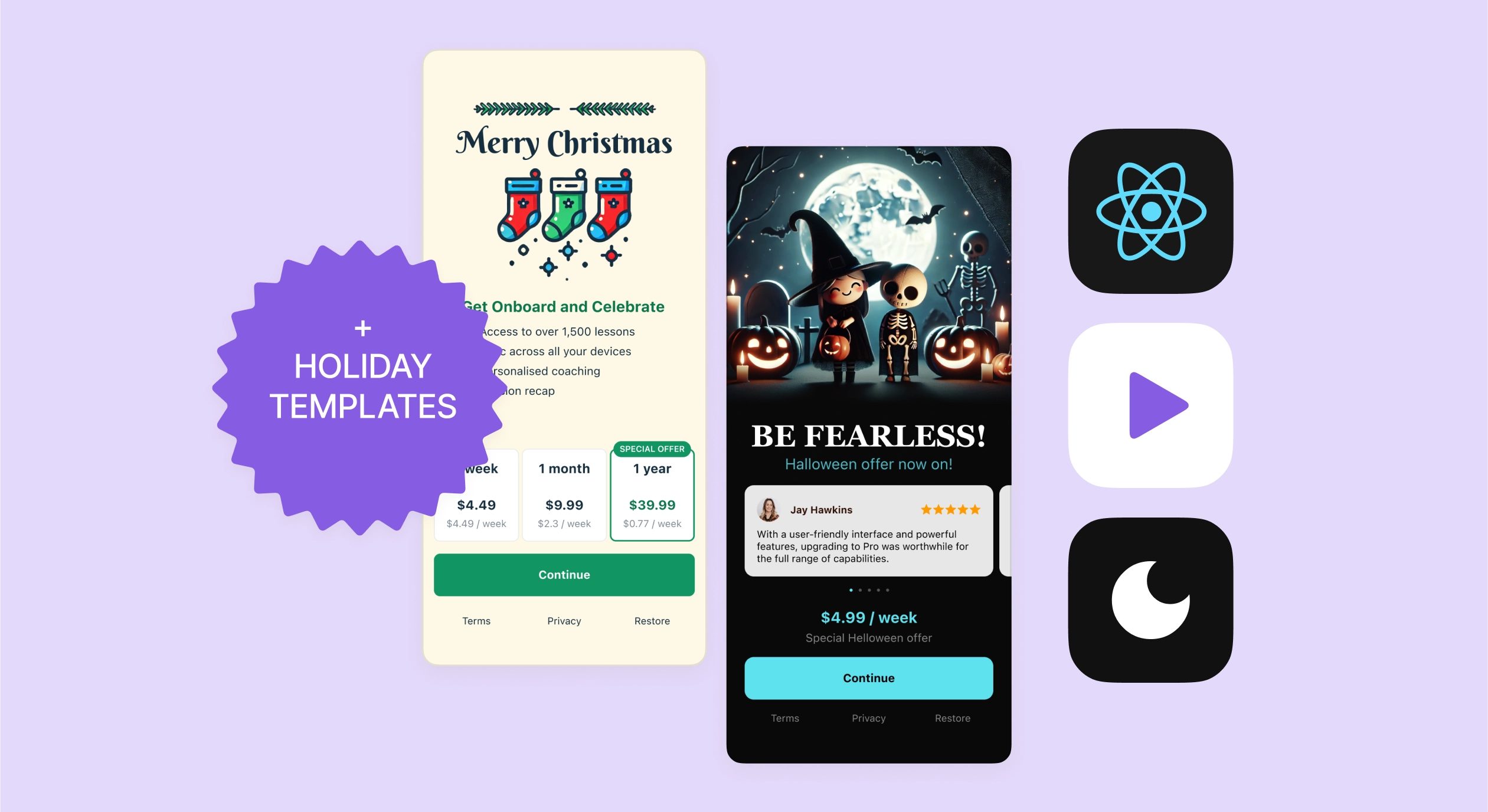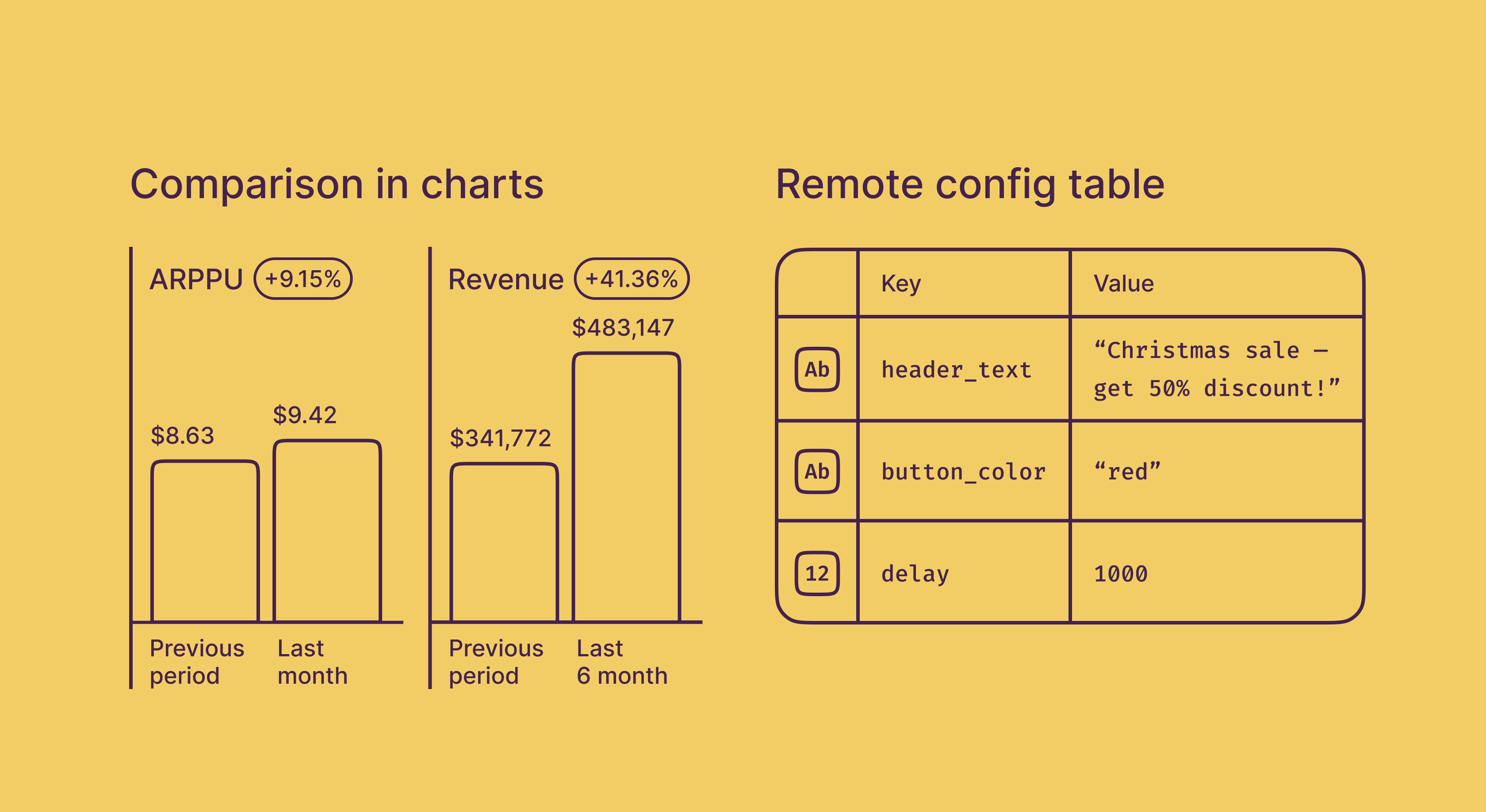ASO metrics and KPIs: How to measure your app’s success

June 28, 2023
20 min read

Congratulations! You finally published your app in the App Store. Now what? Paid traffic is getting more expensive, and you’d love to have some organic users stumble into your app cost-free. That’s where App Store Optimization, or ASO, comes in.
ASO is about improving an app’s visibility in stores like Google Play or App Store to increase its discoverability and the number of downloads. Think of it like SEO: in its core, you also have to mine relevant keywords, search trends, and customer behavior data to make sure your app is visible to more people.
App Store Optimization metrics often include keyword rankings, conversion rates, number of downloads, as well as user reviews, ratings, and retention rates. With these datasets, publishers can understand how to measure their app’s performance and user satisfaction. With the market becoming increasingly competitive, a well-executed ASO strategy backed by meticulous tracking of app KPI metrics can significantly improve your product’s discoverability, customer base, and ultimately its success.
That’s why we prepared this ASO guide to get you up to speed with the basics and the more important details of the trade. We will go over the key performance factors of an app store presence, like store ranking and keyword tracking, as well as some user conversion and retention metrics. By finishing it off with some evaluation tools and frameworks, you will have a full picture of how ASO analytics work, and how you can quickly launch them.

Key ASO metrics and KPIs
As a solution built to boost your monetization strategy, Adapty is all about data-driven decisions. So, since ASO is about constant tracking and improvement of several app KPI metrics, we should start by learning what those are.
App Store rankings. Your position in the stores is crucial: users will more likely discover and download your app if it’s on the top of the page. Again, the SEO comparison is useful: most of us stop at the first page of the search results, and these 10 websites grab most of the organic traffic.
Keyword rankings refer to the position your app holds when users search for specific keywords in the Store. For example, if you have a workout tracker, you’d want it to rank highly for keywords like “fitness,” “workout,” and “exercise.” If your app is ranking high for relevant keywords (top 10, for instance), this indicates effective keyword optimization and increases chances of discoverability.
Conversion rate is the percentage of users who download your app after seeing its store page. A high CR (≈20–40%) means your store page effectively shows the value of your app. Many things influence this metric, especially the screenshots, and videos.
User retention. This metric measures how many users continue to use your app over time, after downloading it. This vital indicator signifies your product’s value to users, and high user retention rates indicate good user satisfaction. A benchmark retention rate for 30 days is often around 20% but can vary widely by app type and market.
User reviews and ratings. Real testimonials serve as a qualitative metric providing insight into user satisfaction and perception of your app. High ratings (4+ stars) positively influence conversion rates and App Store rankings, while reviews can offer invaluable feedback for improvement.
Organic and inorganic downloads. These metrics help you understand how users discover your app, either through search (organic) or advertising (paid downloads). A healthy balance of both is ideal, as it indicates a well-rounded acquisition strategy.
By tracking these app store optimization metrics, you can see the full picture of your ASO strategy, improve user acquisition and retention, and ultimately, boost its revenue. Adapty can assist with effective subscription analytics and price testing, making sure all your hard work literally pays off.
Tracking App Store rankings
Store rankings fundamentally impact your app’s visibility, influencing how easily potential users can discover it. The higher it ranks, the more visibility and downloads it gets. That’s why monitoring it is crucial to understand your app’s position in the marketplace relative to competitors.
App Store ranking is also essential for tracking the success of your marketing campaigns. Fluctuations in rankings are indicative of user behavior reacting to updates you’ve made. Think of it as a bird in the canary that signals upcoming changes in downloads and revenue.
Factors that influence app rankings and tools to track them
Since the app rankings are the ultimate indicator of the whole ASO strategy, the factors that influence your position in the ranks and search results are pretty much the same as we have discussed above. Most of them are about how satisfied the users are using your product.
Conversion rate shows how transparent and effective your store page is at exciting people into downloading your app. But it’s not only about the share of downloads — their number is also the key indicator of quality. Be careful to bring a lot of low-quality traffic, though, because quick install-and-delete patterns can negatively affect your position in the stores.
Here is where user engagement comes in. It is another important factor that shows how often people use your app and how satisfied they are with it. Churn rate, for example, informs you about the percentage of people who leave your app, and tracking this metric helps you to detect inefficiencies in your retention strategies.
Of course, there’s no more direct way to learn what people think about your product than to read user reviews and ratings. That’s why almost every app sooner or later asks you to rate them in the store, and you should consider employing a similar technique.
Improving these factors involves a deep understanding of your users, continuous effort in maintaining and improving your product, and effectively using ASO techniques. Regular tracking and analysis of these metrics will help to gradually improve your app’s ranking.

Measuring keyword rankings
Keywords play a pivotal role in App Store Optimization, functioning as the bridge between user search queries and your service. They’re the crucial terms and phrases that potential users input when searching for apps, and their effective use can significantly increase the chances of your service appearing in those search results.
There are several strategies for selecting and optimizing relevant keywords for ASO:
Understand your app’s core functionality and features and think about what terms users would likely use when searching for an app like yours. Utilize tools like Google’s Keyword Planner or Sensor Tower to identify high-volume, relevant search terms.
Study your competitors: look at the keywords they are targeting, especially those with successful, similar apps. Their targeted keywords could provide additional ideas, and you might also discover gaps that your product could fill.
Consider using long-tail keywords: longer, more specific keyword phrases. While they might have lower search volumes individually, they can collectively bring substantial traffic and often entail less competition.
Regularly monitor and adjust your keywords based on their performance and changing trends. User language and search behavior can evolve, and your ASO strategy must adapt accordingly. We have a whole guide dedicated to this — check it out!
Analyzing conversion rates
Here, conversion rate (CR) refers to the percentage of users who download your app after viewing its store page. It’s a critical metric and a direct indicator of your ability to attract and convince potential users. Here’s what affects the conversion rate:
Icon. It is the first visual element a user sees, so it should be eye-catching, unique, and accurately represent your app’s purpose.
Screenshots and videos. Screenshots and preview videos give potential users a glimpse of your app’s user interface and functionality. High-quality, informative visuals can make a strong impact on the user’s decision to download. Check out our guide about screenshots for App Store optimization here.
App descriptions. These should clearly and concisely convey the features and benefits — and, as we discussed earlier, use relevant search queries and keywords.
User reviews and ratings. Positive reviews and high ratings can significantly enhance the perceived value of your app, influencing potential users to download it.
By optimizing these factors, you can enhance your product’s appeal, improve its conversion rate, and drive more downloads, which ultimately leads to more profit for your app.
Tips for improving conversion rates
Improving App Store Optimization (ASO) conversion rates involves a thoughtful blend of strategic and creative efforts. Here are some tips and best practices:
Optimize app title and description. They should be catchy and incorporate the most searched-for keywords. The description should highlight the unique features and benefits of your product. Make sure it’s clear, concise, and engaging.
Enhance the visual appeal. Your app icon should be distinctive and relevant, and videos and screenshots should be high quality, showcasing the key features.
Encourage reviews and ratings. Positive feedback enhances the app’s credibility. Prompt users to leave reviews, but don’t disrupt the user experience.
Update regularly. This would show that your app is actively managed and helps improve its reliability. In the update notes, show what changes have been made.
A/B testing. Experiment with different versions of your app listing to identify what works best, using tools like Google Experiments.
2024 subscription benchmarks and insights
Get your free copy of our latest subscription report to stay ahead in 2024.
Evaluating user retention
User retention is crucial in measuring app success and long-term sustainability, as well as an important ASO metric. If you can keep your users engaged over a period of time, your app is considered worth showing to others, and the network effect gears up. And of course, high retention indicates that people are seeing the value in your product.
Retained users are more likely to become loyal, contributing to a consistent user base and steady revenue stream. That’s why investing in user retention is often more cost-effective than acquiring new customers: instead of spending money on promotion, you get new people by word of mouth and organically, in the App Store.
This is actually the key reason we mention user retention in this article: stores consider this factor in their ranking algorithms, placing the more trusted (as in used more frequently) apps higher in the search results and the rankings. Here’s what you should keep in mind.
Top user retention metrics
Retention rate is the percentage of users who return to your app after their first visit within a specific period. For example, if 100 users install your app on Day 1 and 20 of them use it again on Day 7, your Day 7 retention rate is 20%. It’s a direct measure of user retention and is commonly used to assess the ability to engage users over time. The most common are D1, D7, and D30 (First, seventh, and thirtieth days).
Churn rate is the opposite of the retention rate and refers to the percentage of users who stop using your app within a given period.
Daily/Weekly/Monthly Active Users (DAU/WAU/MAU) refers to the number of unique users who engage with your app in a single day, week, or month. It provides a snapshot of your app’s engagement on a short- or mid-term basis. DAU can fluctuate due to various factors like weekends or marketing campaigns, so MAU is used more often to analyze longer-lasting trends.
Cohort analysis. This analysis involves grouping users based on a shared characteristic (like install date) and tracking their behavior over time. It helps identify trends and patterns in user retention and can provide insights into how updates or acquisition campaigns affect user behavior. Adapty has this feature too so that our partners can track the efficacy of different subscription offers.
By using these metrics in tandem, you can see the bigger picture, identify areas for improvement, and devise strategies to enhance user engagement and loyalty.
Strategies for improving user retention
Most such strategies are aimed at providing value and engaging experiences to your audience, so the product – and the user it is built for – comes first. It’s especially important for subscription-based apps: if you ask for payment straight away, with little to no features presentation or at least limited access to see what’s behind the paywall, you may run into a lot of same-day installs and deletes which can negatively impact your app’s rankings.
To give your retention a little push, you can also you some of these approaches:
User onboarding. A seamless, intuitive onboarding experience can set the tone for user engagement and care for the customers at their most vulnerable period. Teach users how to navigate your app and highlight its unique features and benefits.
Regular updates. Regular updates demonstrate that you’re dedicated to improving the user experience. Updates can fix bugs, add features, or enhance functionality based on user feedback. Explain important improvements not just in the release notes, but also in the app itself.
Personalization. Personalized experiences cater to individual user needs and preferences, which can significantly boost engagement and retention. Let the customers adjust the app settings to their own liking.
Push notifications. Used carefully, push notifications can remind people about your service, encourage usage, and provide valuable information. Make sure not to overdo it, of course, or your app will be at risk of being deleted or ignored.
In-app rewards. Offering rewards for using certain features or achieving milestones can motivate users to keep using your app. Games often use this technique, providing big bonuses after 7, 10, or 30 consecutive visits.
Analyzing retention metrics provides valuable insights into user behavior. Look for trends in when and why users drop off, and identify successful user pathways and behaviors that lead to long-term retention.
Cohort analysis is particularly useful for identifying how changes in your app or external factors influence retention over time, or how well an audience from a specific marketing campaign performs compared to an average user.
Tools and analytics for ASO metrics
Tracking and analyzing ASO metrics and KPIs require robust tools. Here are some popular choices, each offering distinct features and capabilities:
Data AI (formerly App Annie) is a comprehensive platform offering a wealth of ASO and market data. Key features include keyword and competitor tracking, performance insights, market analysis, and usage intelligence. With its extensive data, Data AI is excellent for monitoring overall app performance and gaining market insights.
Sensor Tower provides powerful ASO features such as keyword optimization, competitor analysis, and visibility scores. With its ‘Store Intelligence’ feature, you can access detailed performance metrics and market trends.
Mobile Action is a similar tool, but its ‘Keyword Intelligence’ AI-powered tool helps understand keyword volume and competition.
AppRadar offers ASO and app marketing functionalities such as keyword tracking, competitor analysis, and organic user acquisition tracking. Its unique feature is its focus on user attribution and ad tracking, which is great for those using paid ads alongside their ASO efforts.
StoreMaven focuses on A/B testing for app store listings, which is crucial for improving conversion rates. With its data-driven approach, you can optimize your store page to maximize downloads.
Remember, while these tools provide valuable insights and recommendations, human interpretation and strategic application of these insights remain crucial. Understanding your app’s unique context, target audience, and market position is key to the App Store’s success.

Interpreting ASO data and making informed decisions
Collecting data for ASO is not enough; you need to interpret it skillfully. Analyzing ASO data effectively helps identify what’s working, what’s not, and how to improve. Here’s how you can analyze ASO data effectively and draw meaningful insights:
Set and prioritize goals. You will see soon enough that some goals contradict each other and can’t be pursued simultaneously. Set clear, measurable goals in your App Store Optimization process and prioritize them in order of the biggest ROI.
Don’t confuse goals & KPIs. If the goals are where you want to go, KPIs are just the speed at which you need to drive. Keep the end result — loved and used application — in mind and don’t implement mindless “growth hacking” techniques that will push your app today but hurt its value in the long term.
Identify trends and patterns. Look for trends in your ASO data. If there’s a spike in downloads, investigate what caused it. If there’s a drop in user retention, analyze user feedback to pinpoint issues. By observing patterns, you can predict future performance and make proactive adjustments, and cohort analysis is perfect for this.
Benchmark against competitors. Tools like App Annie and Sensor Tower allow you to measure your performance and compare it with competitors. Understanding your competitive landscape can help identify opportunities for differentiation and improvement.
Test, learn, implement. A/B testing different elements of your store listing (like icons, screenshots, and descriptions) can reveal what resonates with users, helping to boost conversion rates. These learnings form the base for successive launches.
Conclusion: ASO analytics pays off quickly
Remember, ASO is an ongoing process. Effective App Store optimization enhances visibility, boosts download rates, improves user retention, and contributes to long-term sustainability. Key metrics such as store rankings, keyword rankings, conversion rates, and user retention provide insights into your app’s performance and user behavior.
And once you’ve mastered retaining the user base, Adapty is here to help you monetize it. We provide comprehensive solutions for subscription tracking, boosting in-app purchases, and analytics. With tools like cohort analysis and paywall builder, your team will have plenty of data to make informed decisions.







